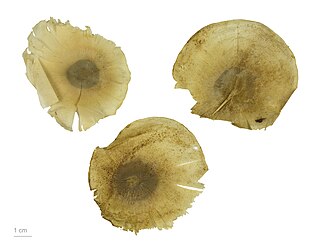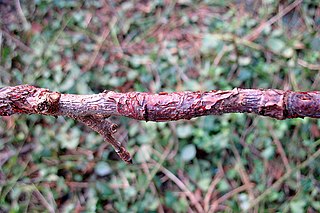
Aspidosperma cylindrocarpon is a timber tree native to Brazil, Paraguay, Bolivia, and Peru. It is common in Atlantic Forest, Cerrado and Pantanal vegetation of Brazil. This plant is cited in Flora Brasiliensis by Carl Friedrich Philipp von Martius. In addition, it is useful for beekeeping.

Aspidosperma is a genus of flowering plant in the family Apocynaceae, first described as a genus in 1824. It is native to South America, Central America, southern Mexico, and the West Indies.
Cylindrocarpon magnusianum is a fungal plant pathogen that causes root rot in alfalfa and red clover.
Nectria radicicola is a plant pathogen that is the causal agent of root rot and rusty root. Substrates include ginseng and Narcissus. It is also implicated in the black foot disease of grapevine. It is of the genus Nectria and the family Nectriaceae. N. radicicola is recognizable due to its unique anatomy, morphology, and the formation of its anamorph Cylindrocarpon desructans.
Cylindrocarpon ianthothele var. ianthothele is a fungal plant pathogen.
Cylindrocarpon candidum is a fungal plant pathogen that causes cankers on elm.
Cylindrocarpon musae is a fungal plant pathogen that causes root rot in banana.
In enzymology, a dimethylglycine oxidase (EC 1.5.3.10) is an enzyme that catalyzes the chemical reaction

Cypripedium calceolus is a lady's-slipper orchid, and the type species of the genus Cypripedium. It is native to Europe and Asia.

Eugenitin is a chromone derivative, a type of phenolic compound found in cloves. It has also been isolated from the fungal species Cylindrocarpon sp. C.M.I. 127996.

Neonectria is a genus of fungi in the family Nectriaceae.
Peroba, paroba, parova, perobeira, perova and peroveira are common names for various tree species in the families:
Ketosteroid monooxygenase (EC 1.14.13.54, steroid-ketone monooxygenase, progesterone, NADPH2:oxygen oxidoreductase (20-hydroxylating, ester-producing), 17alpha-hydroxyprogesterone, NADPH2:oxygen oxidoreductase (20-hydroxylating, side-chain cleaving), androstenedione, NADPH2:oxygen oxidoreductase (17-hydroxylating, lactonizing)) is an enzyme with systematic name ketosteroid,NADPH:oxygen oxidoreductase (20-hydroxylating, ester-producing/20-hydroxylating, side-chain cleaving/17-hydroxylating, lactonizing). This enzyme catalyses the following chemical reaction
Campylocarpon is a genus of ascomycete fungi in the family Nectriaceae. The genus was described in 2004. The two species in the genus, C. fasciculare and C. pseudofasciculare, are associated with black foot disease of grapevines, in which the roots develop black, sunken, necrotic lesions.
Campylocarpon fasciculare is a species of parasitic fungus in the family Nectriaceae, and the type species of the genus Campylocarpon. Described as new to science in 2004, it is one of several pathogens associated with black foot disease in grape.
C. ehrenbergii may refer to:
The black foot disease is a grapevine trunk disease. It is caused by fungi in the genus Cylindrocarpon.
Colin Booth was an English mycologist, known a leading authority on the genus Fusarium.




